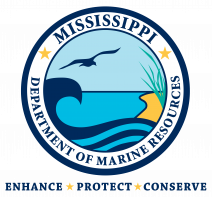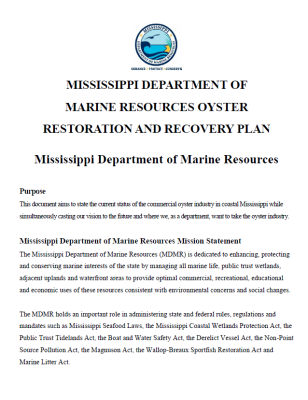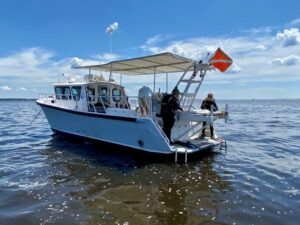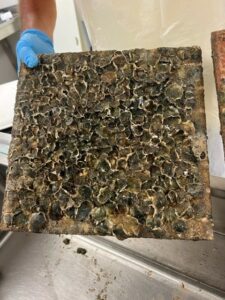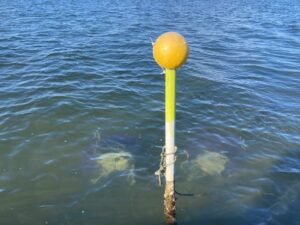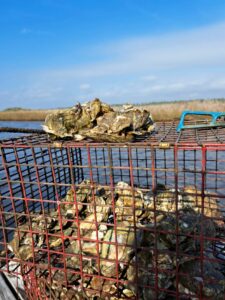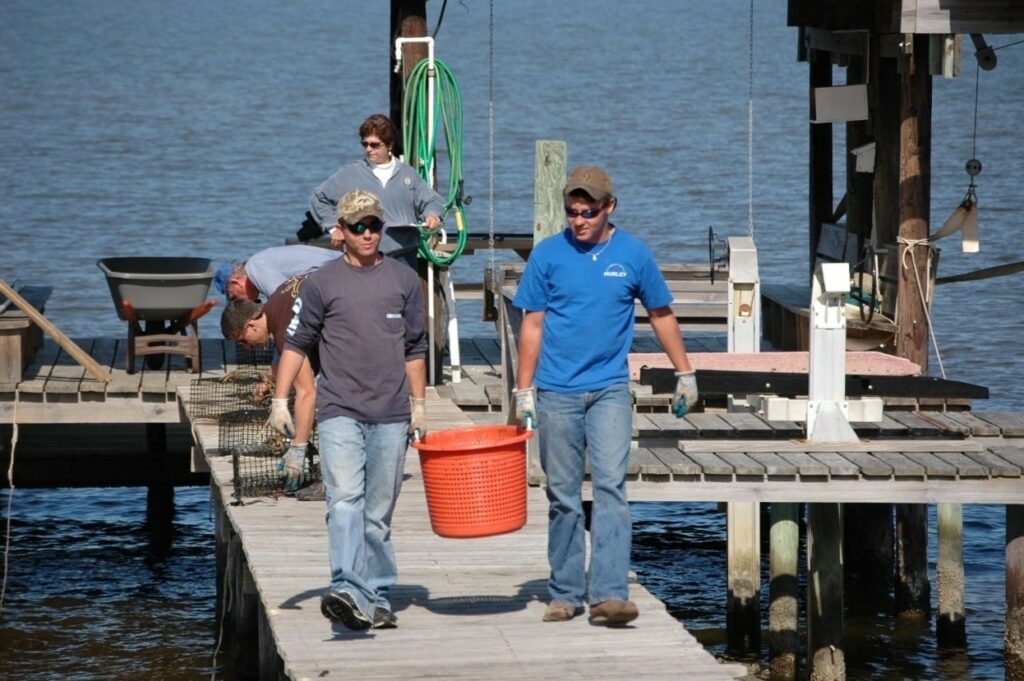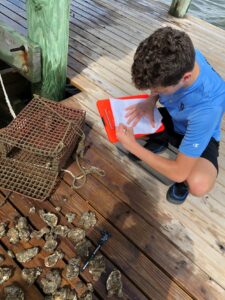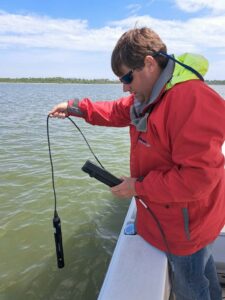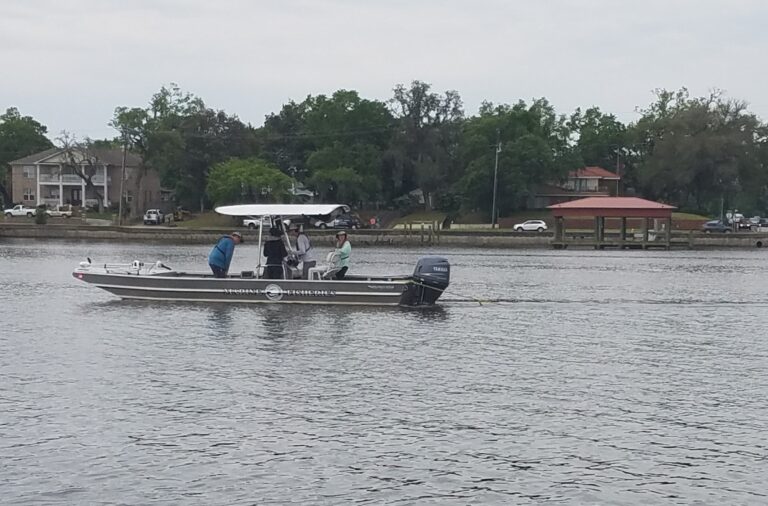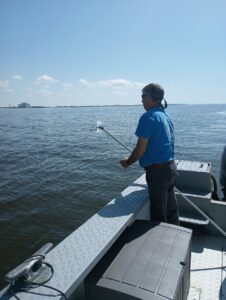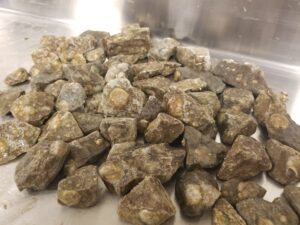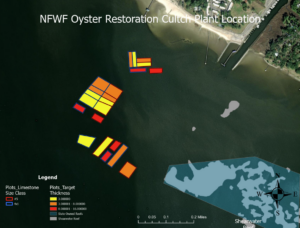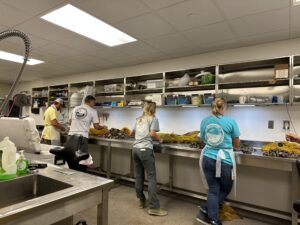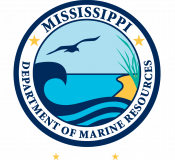MANAGEMENT PROJECTS
Oyster Restoration and Recovery Plan
Over the past decade, Mississippi’s oyster resource has declined greatly due to several natural and man-made disasters such as Hurricane Katrina, the Deepwater Horizon oil disaster, and multiple Bonnet Carré Spillway openings. The decline in the oyster population across the Mississippi Sound has been devastating for many and continues to threaten the culture and heritage of oyster harvesting that once thrived in Mississippi.
The MDMR Shellfish Bureau is dedicated to the restoration and recovery of the native oyster population. To achieve this goal, the State developed the Mississippi Department of Marine Resources Oyster Restoration and Recovery Plan to reach its goals of increasing oyster harvest and creating new jobs and business opportunities while improving the environment through species recovery and habitat restoration. This document aims to present the current status of the commercial oyster industry in coastal Mississippi while simultaneously casting our vision to the future and where we, as a department, want to take the oyster industry.
ANNUAL REEF ASSESSMENT
To manage Mississippi’s oyster resources, the MDMR performs annual reef assessments that aid in monitoring the health of our state-owned reefs. Reef assessments help determine a sustainable harvest, monitor predation and disease, calculate mortalities and recruitment, record environmental conditions including hydrology and bottom type, and determine where and how to focus future restoration efforts. In the past five years, 1,451 square meter dives and 424 dredge tows have been performed on all major reef complexes in the Mississippi Sound.
There are two methods used by the Shellfish Bureau to conduct reef assessment: Square Meter Dives and One-Minute Dredge Tows.
- Square Meter Dives: conducted during the spawning season of May-October, yields quantitative data that can be analyzed for precise interpretation.
- One-Minute Dredge Tows: conducted in the spring, mimics the practice of oyster dredge harvesters and provides qualitative insights.
CULTCH PLANTING PROGRAM
The Cultch Planting Program restores and enhances oyster reefs through the placement of cultch materials, such as crushed concrete, limestone, and/or cleaned oyster shells, in suitable habitats for oyster growth. Cultch replacement and replenishment is a critical component of sustaining healthy oyster populations in Mississippi, especially given the recent environmental disasters that have impacted oyster resources in the state.
Cultch placement areas are determined through side-scan sonar and settlement patterns discerned from previous years. Monitoring cultch placement areas pre and post deployment provides a permanent record that will be used to detect changes over time and provide accurate measurements of coverage while simultaneously providing accurate GPS coordinates.
REMOTE OYSTER SETTING FACILITY PROJECT
Remote setting involves the placement of oyster larvae onto cultch material at a separate location, away from the hatchery itself. During this process, the larvae are provided with high-quality substrate to settle on, an abundant food supply, and favorable water quality conditions to optimize their chances of survival.
The Mississippi Department of Marine Resources (MDMR) is currently in Phase I of the RESTORE Council-funded Remote Oyster Setting Facility Project. This initiative aims to establish a dedicated facility that can accelerate the restoration of Mississippi’s oyster reefs at a much faster pace than what could be achieved through natural means alone. The primary goal of this project is to produce oyster spat on shell, which will then be strategically planted on historic reefs. By doing so, we aim to protect and restore the rich coastal and marine resources in Mississippi, enhance community resilience, and preserve and improve our valuable water resources.
Through the Remote Oyster Setting Facility Project, we are committed to the comprehensive restoration and preservation of our oyster reefs. This undertaking aligns with our mission to safeguard and enhance the ecological integrity of our coastal areas. By promoting sustainable practices and leveraging innovative techniques, we strive to foster a thriving ecosystem that benefits both the environment and our local communities.
RECRUITMENT AND SETTLEMENT PATTERNS OF OYSTER SPAT
Oyster spawning produces free-swimming larvae that attach to a hard material on the seafloor. These attached larvae are called spat and, over time, will grow to a harvestable size. Eastern oyster (Crassostrea virginica) settlement has been well documented in the Mississippi Sound through the MDMR’s annual reef assessment. Typically, spat sets are seen from early summer through the fall, however, sampling primarily occurs from May to October leaving the rest of the year without a monitoring program of possible spawning. This project is designed to continuously monitor reproduction of the Eastern oyster in the Mississippi Sound across multiple years.
Settlement plates deployed in the western Mississippi Sound, Biloxi Bay, and Pascagoula Bay are used to document spatial-temporal variation in spat settlement throughout the year. Every four weeks, staff will retrieve old plates, count and measure all spat, and deploy new settlement plates. Determining localized oyster spawning trends will give the Shellfish Bureau insight into the prime locations and months to build and replenish reefs in the Mississippi Sound. The findings of this project will improve the effectiveness of oyster restoration on the Mississippi Gulf Coast.
MISSISSIPPI OYSTER GARDENING PROGRAM
The Mississippi Oyster Gardening Program (MOGP) is a collaborative effort between Auburn University Marine Extension and Research Center (AUMERC), Mississippi Department of Marine Resources (MDMR), and Mississippi Department of Environmental Quality (MDEQ) with funding through the Mississippi-Alabama Sea-Grant Consortium. Oyster gardening is a volunteer-based project with the purpose of providing education to the local community and a hands-on opportunity to aid in reef restoration. Oyster gardens are suspended from piers, hanging midway in the water column to provide habitat and help to clean the water. Gardens are stocked with hatchery-reared juvenile oysters, known as spat, that have set on loose oyster shell.
Participants of the program maintain their gardens by shaking the oysters to clear any mud or other fouling that could potentially reduce water flow, and by monitoring for potential predators. The only requirements to participate are access to waterfront property with a pier or landing and a few minutes to shake and maintain the gardens and check for predators once a week. Gardens, oysters, and all necessary gear are provided by MOGP at no cost to the gardener. To become an oyster gardener, visit the website at oystergardening.org and click on the link to apply.
SHELLFISH SANITATION PROGRAM
To ensure the sanitary control of molluscan shellfish produced for human consumption within the State of Mississippi, the MDMR Shellfish Bureau closely monitors the water quality of growing waters through routine sampling and conducting annual shoreline surveys to identify and evaluate sources of pollution threatening oyster reefs. Fecal coliforms are a group of bacteria that indicate the possible presence of pathogenic bacteria, viruses, and protozoans from human and/or animal waste. Monitoring oyster growing waters for elevated fecal coliform levels mitigates risks to human health from consumption of raw contaminated shellfish. The MDMR Shellfish Bureau performs monthly water quality analyses for the presence of fecal coliforms at 75 sample locations across the Mississippi Sound.
The NSSP Model Ordinance defines a sanitary survey as “the written evaluation report of all environmental factors, including actual and potential pollution sources, which have a bearing on the water quality in a shellfish growing area”. During this work, MDMR staff travel by vehicle and/or boat to the adjacent shoreline of harvestable growing waters and conduct an inspection of the area. Staff evaluates actual or potential pollution sources, their distances from pollution sources to growing area and impact of each source in growing area, they assess wastewater treatment plants by speaking with plant managers and consider the presence of domestic and wild animal populations. All findings are summarized into a report and included in the MDMR Operational Plan.
Oyster Management and Restoration - Phase 1
Understanding where and how to effectively restore oyster reefs is fundamental to oyster reef restoration in the Mississippi Sound. To improve oyster populations in coastal Mississippi, the Oyster Restoration and Management Project investigates how oyster resiliency and productivity can be improved. While the project is comprised of many different studies, one evaluates the effectiveness of limestone cultch material for spat recruitment as well as oyster survival by comparing different material sizes and reef height.
Typically, limestone pieces deployed during cultch plants are roughly the same size and evenly distributed in the area at a low height from the seafloor. Other studies in the North Gulf of Mexico sited that oysters at a higher relief from the seafloor tend to be more productive due to the frequent environmental disturbances, such as low dissolved oxygen, sedimentation, and storms. This Oyster Restoration and Management project analyzes if a change in reef relief and cultch material size will increase or hinder the number of spat growing on the reef and oyster survivability at three 10-acre plots in Biloxi Bay. These sites will be monitored for multiple years.
This project is funded by the National Fish & Wildlife Foundation Gulf Environmental Benefit Fund (NFWF GEBF) and led by the Mississippi Department of Environmental Quality (MDEQ) and in coordination with the MDMR. Findings will provide the MDMR with information needed to improve the cost-effectiveness and sustainability of future large-scale restoration projects.
Back to Top
